HOME
ANIMALS
PREHISTORIC
Pterosaurs
(Greek ptero,"wing"; sauros,"lizard")
Ancestory
The ancestors of dinosaurs were crocodile-like creatures called
archosaurs. They appeared early in the Triassic Period and
diversified into a variety of forms. Some archosaurs gave rise to
true crocodiles. Other archosaurs adopted a two-legged posture and
developed S-shaped necks, and it was certain species of these
reptiles that eventually evolved into dinosaurs. Still others gave
rise to pterosaurs.
Introduction
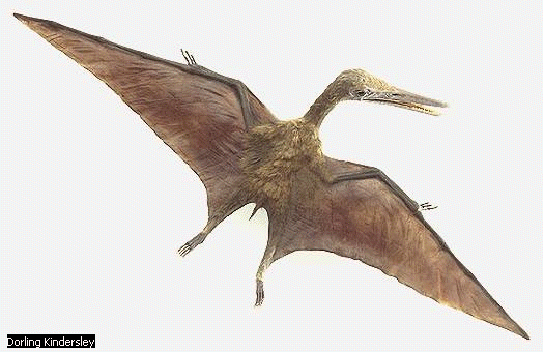 Ranging
from the size of a sparrow to the size of an airplane, the
pterosaurs ruled the skies in the Jurassic and Cretaceous Periods,
and included the largest vertebrate ever known to fly. The appearance
of flight in pterosaurs was separate from the evolution of flight in
birds and bats; pterosaurs are not closely related to either birds or
bats, and thus provide a classic example of convergent evolution.
Ranging
from the size of a sparrow to the size of an airplane, the
pterosaurs ruled the skies in the Jurassic and Cretaceous Periods,
and included the largest vertebrate ever known to fly. The appearance
of flight in pterosaurs was separate from the evolution of flight in
birds and bats; pterosaurs are not closely related to either birds or
bats, and thus provide a classic example of convergent evolution.
Pterosaurs existed during the Mesozoic era from the Late Triassic
period nearly to the end of the Cretaceous period. Many fossil
remains of pterosaurs, which are often popularly referred to as
pterodactyls, have been found in all continents except Antarctica;
about 60 genera have been discovered. Pterosaurs did not have
feathers. The wings were thin membranes of skin, similar to the wings
of a bat, which extended along the sides of the body, and were
attached to the extraordinarily long fourth finger of each arm. The
bones were hollow and had openings at each end. Unlike typical
reptiles, pterosaurs had a breastbone that was well developed for the
attachment of flight muscles and a brain that was also more developed.
In early pterosaurs the skull was about 3.5 inches long and the body
was about 4 inches long. The flexible tail, which was about 15 inches
long, had a diamond-shaped terminal appendage, used as a rudder in
controlling flight. Later pterosaurs of the Upper Cretaceous period
had a wingspread of more than 20 feet. The skull was long and slender
and the jaws were toothless.
Early in 1975 scientists announced that partial skeletons of three
huge, long-necked pterosaurs had been discovered in the Late
Cretaceous non-marine rock at Big Bend National Park in Texas. With
an estimated wingspan of about 36-40 feet, the Big Bend pterosaur is
the largest flying creature known to have existed.
Rhamphorhynchus
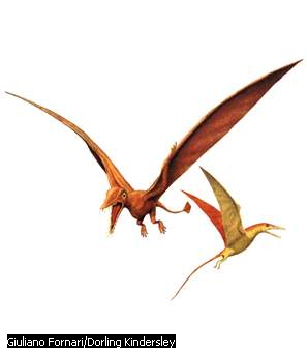 (Greek
for "beaked snout") One of the genera of pterosaur that
lived in parts of Europe and Africa in the late Jurassic Period
(about 163 million to 144 million years before present). Pterosaurs
were relatives of dinosaurs, but they were not true dinosaurs. Two
types of pterosaurs lived during the Jurassic Period: a long-tailed
group and a short-tailed group. Rhamphorhynchus was of the long-tailed
type-its tail was long and stiff with a kite-shaped flap at its tip
for balance. The leathery wings had many stiff fibers running between
the wing front and back that provided support and prevented tearing.
The wings of Rhamphorhynchus had a span of up to 6.5 feet. On a few
fossils found in Germany, an outline of the wings can be seen. Other
fossils of pterosaurs show hairlike structures on the body,
suggesting that at least some of these reptiles may have been warm-blooded.
(Greek
for "beaked snout") One of the genera of pterosaur that
lived in parts of Europe and Africa in the late Jurassic Period
(about 163 million to 144 million years before present). Pterosaurs
were relatives of dinosaurs, but they were not true dinosaurs. Two
types of pterosaurs lived during the Jurassic Period: a long-tailed
group and a short-tailed group. Rhamphorhynchus was of the long-tailed
type-its tail was long and stiff with a kite-shaped flap at its tip
for balance. The leathery wings had many stiff fibers running between
the wing front and back that provided support and prevented tearing.
The wings of Rhamphorhynchus had a span of up to 6.5 feet. On a few
fossils found in Germany, an outline of the wings can be seen. Other
fossils of pterosaurs show hairlike structures on the body,
suggesting that at least some of these reptiles may have been warm-blooded.
Rhamphorhynchus appears to have been well adapted for
catching fish. Its strong shoulder girdle and wings show that this
animal was probably a powerful flier. It may have thrust its head
into the water to spear fish with its long pointed teeth as it
skimmed the water surface, or it may have been a diving hunter,
catching fish underwater. The jaws would have clamped tightly shut as
the teeth interlocked around a fish. Although the teeth are known to
have pointed forward and outward, they may have formed an effective
cage for trapping fish. A fish has been found fossilized within one
fossil specimen of Rhamphorhynchus.
Quetzalcoatlus
The largest pterosaur (wonderfully named for the Aztec
winged serpent god) had a wing span of about forty feet. The wing's
main support was an amazingly elongated fourth digit in the hand.
Fibers in the wing membrane added structural support and stiffness.
At least some pterosaurs may have had some sort of hair-like body
covering, which could very well mean that they were warm-blooded.
Pterosaurs had a diverse range of head types. Their ability to fly
probably allowed them to evolve into many niches, taking advantage of
many different food sources, which would explain the range of skull shapes.
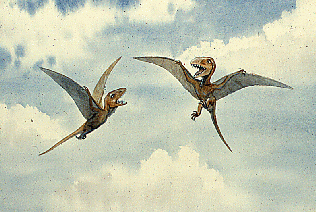
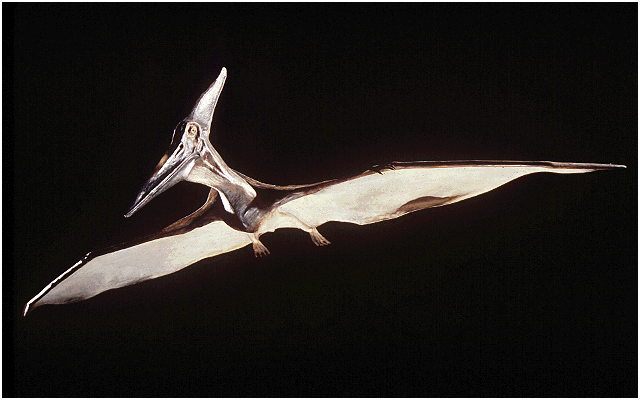
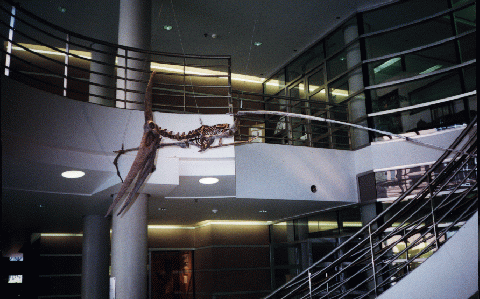
 Ranging
from the size of a sparrow to the size of an airplane, the
pterosaurs ruled the skies in the Jurassic and Cretaceous Periods,
and included the largest vertebrate ever known to fly. The appearance
of flight in pterosaurs was separate from the evolution of flight in
birds and bats; pterosaurs are not closely related to either birds or
bats, and thus provide a classic example of convergent evolution.
Ranging
from the size of a sparrow to the size of an airplane, the
pterosaurs ruled the skies in the Jurassic and Cretaceous Periods,
and included the largest vertebrate ever known to fly. The appearance
of flight in pterosaurs was separate from the evolution of flight in
birds and bats; pterosaurs are not closely related to either birds or
bats, and thus provide a classic example of convergent evolution. (Greek
for "beaked snout") One of the genera of pterosaur that
lived in parts of Europe and Africa in the late Jurassic Period
(about 163 million to 144 million years before present). Pterosaurs
were relatives of dinosaurs, but they were not true dinosaurs. Two
types of pterosaurs lived during the Jurassic Period: a long-tailed
group and a short-tailed group. Rhamphorhynchus was of the long-tailed
type-its tail was long and stiff with a kite-shaped flap at its tip
for balance. The leathery wings had many stiff fibers running between
the wing front and back that provided support and prevented tearing.
The wings of Rhamphorhynchus had a span of up to 6.5 feet. On a few
fossils found in Germany, an outline of the wings can be seen. Other
fossils of pterosaurs show hairlike structures on the body,
suggesting that at least some of these reptiles may have been warm-blooded.
(Greek
for "beaked snout") One of the genera of pterosaur that
lived in parts of Europe and Africa in the late Jurassic Period
(about 163 million to 144 million years before present). Pterosaurs
were relatives of dinosaurs, but they were not true dinosaurs. Two
types of pterosaurs lived during the Jurassic Period: a long-tailed
group and a short-tailed group. Rhamphorhynchus was of the long-tailed
type-its tail was long and stiff with a kite-shaped flap at its tip
for balance. The leathery wings had many stiff fibers running between
the wing front and back that provided support and prevented tearing.
The wings of Rhamphorhynchus had a span of up to 6.5 feet. On a few
fossils found in Germany, an outline of the wings can be seen. Other
fossils of pterosaurs show hairlike structures on the body,
suggesting that at least some of these reptiles may have been warm-blooded.

